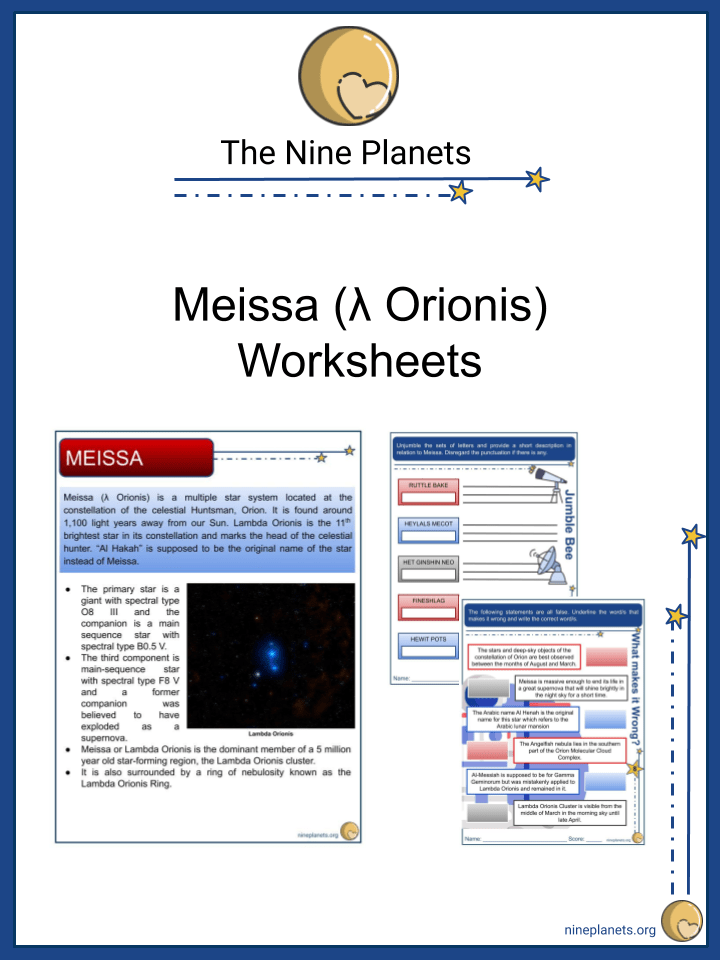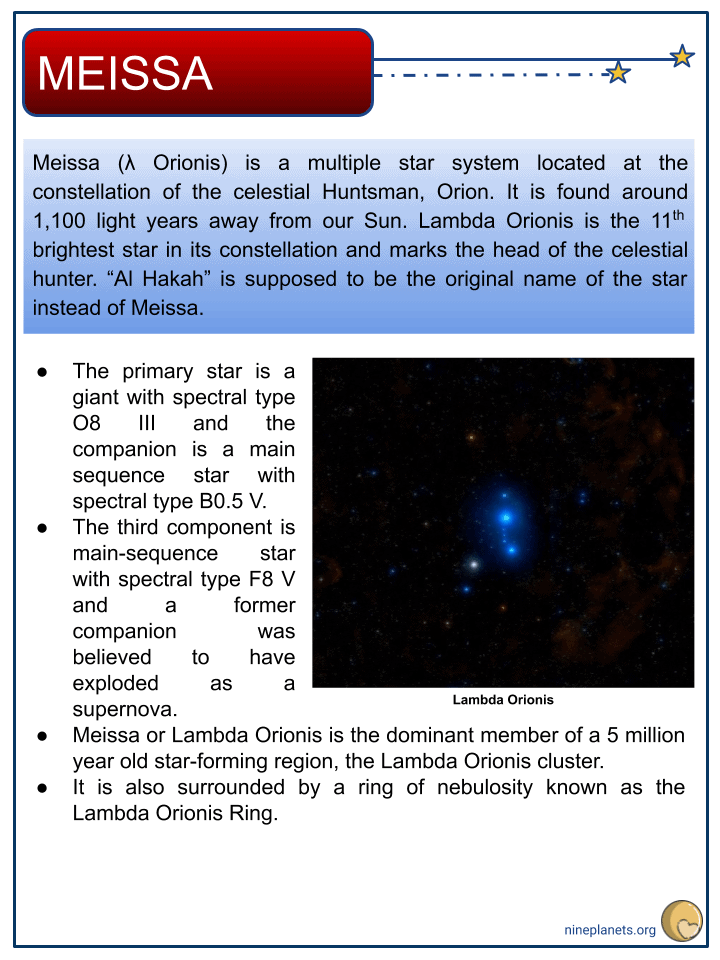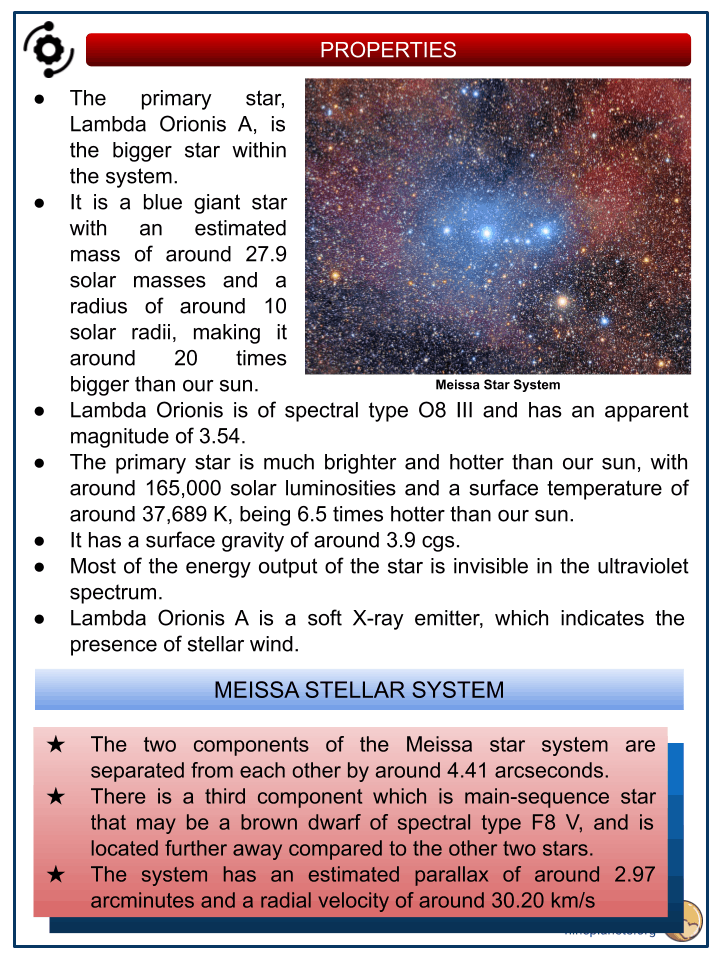Download Meissa (λ Orionis) Worksheets
Click the button below to get instant access to these premium worksheets for use in the classroom or at a home.

This worksheet can be edited by Premium members using the free Google Slides online software. Click the Edit button above to get started.
Download free sample
Not ready to purchase a subscription yet? Click here to download a FREE sample of this worksheet pack.
Resource Examples
Click any of the example images below to view a larger version.




Key Facts & Information
- Meissa (λ Orionis) is a multiple star system located at the constellation of the celestial Huntsman, Orion. It is found around 1,100 light years away from our Sun. Lambda Orionis is the 11th brightest star in its constellation and marks the head of the celestial hunter. “Al Hakah” is supposed to be the original name of the star instead of Meissa.
- The primary star is a giant with spectral type O8 III and the companion is a main sequence star with spectral type B0.5 V.
- The third component is main-sequence star with spectral type F8 V and a former companion was believed to have exploded as a supernova.
- Meissa or Lambda Orionis is the dominant member of a 5 million year old star-forming region, the Lambda Orionis cluster.
- It is also surrounded by a ring of nebulosity known as the Lambda Orionis Ring.
Nomenclature
- The traditional name Meissa derives from the Arabic word Al-Maisan meaning “The Shining One”.
- Al-Maisan is supposed to be for Gamma Geminorum, which is now Alhena, but was mistakenly applied to Lambda Orionis and remained in it.
- The Arabic name Al Hakah, meaning “A White Spot”, is the original name for this star which refers to the Arabic lunar mansion which includes Lambda Orionis and the two stars of Phi Orionis.
- In Chinese, Turtle Beak is an asterism containing the same stars mentioned above, thus, Meissa is known as the First Star of Turtle Beak.
- The Working Group on Star Names by the International Astronomical Union (IAU) approved the name Meissa for the star and this is now listed in the IAU Catalog of Star Names.
- Lambda Orionis is the star’s Bayer designation and it also has other stellar designations: 39 Orionis, 101 G. Orionis, BD+09°879, HIP 26207, and SAO 112921.
- The primary star is designated as HD 36861 and HR 1879.
- The secondary star is designated as HD 36862 and HR 1880.
Properties
- The primary star, Lambda Orionis A, is the bigger star within the system.
- It is a blue giant star with an estimated mass of around 27.9 solar masses and a radius of around 10 solar radii, making it around 20 times bigger than our sun.
- Lambda Orionis is of spectral type O8 III and has an apparent magnitude of 3.54.
- The primary star is much brighter and hotter than our sun, with around 165,000 solar luminosities and a surface temperature of around 37,689 K, being 6.5 times hotter than our sun.
- It has a surface gravity of around 3.9 cgs.
- Most of the energy output of the star is invisible in the ultraviolet spectrum.
- Lambda Orionis A is a soft X-ray emitter, which indicates the presence of stellar wind.
Meissa Stellar System
- The two components of the Meissa star system are separated from each other by around 4.41 arcseconds.
- There is a third component which is main-sequence star that may be a brown dwarf of spectral type F8 V, and is located further away compared to the other two stars.
- The system has an estimated parallax of around 2.97 arcminutes and a radial velocity of around 30.20 km/s
- The secondary star, Lambda Orionis B, is a blue-white main-sequence star.
- It is of spectral type B0.5 V and has an apparent magnitude of 5.61.
- Lambda Orionis B has an estimated mass of around 10.3 solar masses and an estimated radius of around 4.2 solar radii, making it around 8 times bigger than our sun.
- It is also brighter and hotter than our sun with 6,300 solar luminosities and a surface average temperature of around 25,400 K, being 4.3 times hotter than our sun.
- The secondary star has an estimated surface gravity of 4.21.
Meissa In The Future
- It is suggested that a former companion of Meissa had exploded into a supernova and that Meissa itself is destined to take the same path.
- Meissa is massive enough to end its life in a great supernova that will shine brightly in the night sky for a long time.
- A supernova remnant will probably be left behind after the explosion.
Lambda Orionis Cluster
- Meissa is the central member of the open cluster Lambda Orionis Cluster, also known as the Lambda Orionis Association or Collinder 69.
- This cluster is composed of stars with magnitude 4 or 5 that can be seen even with the naked eye.
- Collinder 69 was formed around 5 million years ago.
- It is the interstellar medium that Meissa came from.
- The gas and dust were pulled together by gravity, giving birth to Meissa.
- Observations using the Spitzer Space Telescope show that 25% of the low-mass stars and 40% of the substellar objects in the star cluster are surrounded by a circumstellar disk.
- The Lambda Orionis Cluster orbits through the Milky Way at distances as far as 28,000 light-years from the Galactic Center and as close as 25,000 light-years.
- Lambda Orionis Association is visible from the middle of August in the morning sky until late April.
- It can be seen from observers in both the northern and southern hemispheres.
Lambda Orionis Ring
- Meissa is surrounded by a ring of nebulosity about 12 degrees across which is the Lambda Orionis Ring.
- It is sometimes called the Angelfish nebula due to the resemblance of its lighter areas to an angelfish.
- It is suggested that this nebulosity is the remnant of a supernova explosion.
- The ultraviolet light from Meissa, and the other hot stars in the vicinity illuminates the Angelfish Nebula.
- The nebula can only be seen in long-exposure images as it lies in the northern part of the Orion Molecular Cloud Complex.
- Lambda Orionis Nebula is not visible in binoculars or small telescopes.
- It is surrounded by an expanding gaseous ring which was formed between 2 and 6 million years ago.
- The expansion of the cool gas indicates that the Lambda Orionis Ring may be the remains of a Type II supernova which was a former binary companion of Meissa.
Orion
- Meissa is located in the constellation of the celestial Hunter, Orion.
- The major bright stars of the constellation of the celestial hunter are: Rigel (Beta Orionis, 0.18 mag), Betelgeuse (Alpha Orionis, 0.42 mag), Bellatrix (Gamma Orionis, 1.64 mag), Alnilam (Epsilon Orionis, 1.69 mag), Alnitak (Zeta Orionis, 1.88 mag), Saiph (Kappa Orionis, 2.07 mag), Mintaka (Delta Orions, 2.20 mag), and Meissa (Lambda Orionis, 3.47 mag).
- Meissa marks the head of Orion, while Betelgeuse and Bellatrix mark the shoulders, Saiph and Rigel mark the knees or feet, and Alnitak, Alnilam and Mintaka form Orion’s belt.
- The Orion constellation is also home to a lot of interesting deep-sky celestial objects including nebulae Messier 42, Messier 43, Flame Nebula, Horsehead Nebula and Monkey Head Nebula, the reflection nebulae Messier 78 and NGC 2023, the emission nebula Barnard’s Loop, and the star clusters Trapezium and NGC 2169.
- The stars and deep-sky objects of the constellation of Orion are best observed between January and March.
- The Orionid Meteor Shower is at its peak during the middle of October every year.
- There are around 20 meteors per hour and the parent of the meteor shower is actually Halley’s Comet.